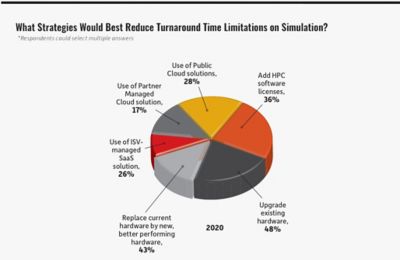-
United States -
United Kingdom -
India -
France -
Deutschland -
Italia -
日本 -
대한민국 -
中国 -
台灣
-
-
产品组合
查看所有产品Ansys致力于通过向学生提供免费的仿真工程软件来助力他们获得成功。
-
ANSYS BLOG
April 26, 2021
Simulation User Survey Results: Evolving Workflows Affect HPC Usage
A third of engineers still limit their model size and fidelity to speed up simulation runs, according to a recent Ansys survey of engineers. However, the latest Ansys HPC simulation survey reveals a shift toward adopting more high-performance computing (HPC) resources — both on-premises and in the cloud — to meet time-to-market and complex simulation challenges.
Ansys launched a research survey last year to find out how engineering organizations are using HPC resources for engineering simulation. HPC – both on-premises and in the cloud – can help engineers address a number of simulation challenges, including demand to accelerate the design cycle, as well as the need for a larger number of simulations throughout the design process.
We also gained some insight into how the recent COVID-19 pandemic had affected adoption of HPC and cloud technologies, given the sudden shift to remote work and remote collaboration. Through the survey, we now have additional understanding into how organizations are using HPC resources, and how that will change over the next 12 months. We are also able to compare the 2020 data to similar survey results we collected in 2014.
In the first of this two-part series, let’s examine some of the key research findings from the survey and what those findings might mean for organizations planning to implement or expand an HPC strategy for simulation. And, because the past year was quite unlike any other in recent history, we will also examine those findings in the context of the COVID-19 pandemic, which drastically altered the way many engineering organizations approached Cloud and HPC platforms in 2020 and beyond.
Changing Workflows Pose Resource Challenges
Engineers face a number of challenges when it comes to expanding the use of simulation across the design cycle. The use of HPC can help overcome those obstacles. According to 52% of respondents, the top business challenge they face with regard to design is the demand to reduce the time required to complete design cycles.
The need to conduct more frequent simulations on increasingly complex models is also running up against the compute restraints faced by these organizations. More than a fifth (21%) of respondents reported that their most frequent simulations are overnight runs (i.e., they take more than 9 hours to complete). Another 45% reported that simulations typically take between 3 and 8 hours (up from 31% in 2014). In addition, 33% almost always limit the model size and amount of detail in simulation models due to turnaround time limitations (compared to 39% in 2014).
Simulation Requires a Mixed Compute Approach
To meet the demand for faster and more accurate simulations, organizations are taking a multifaceted approach to computing resources. The survey results show that companies have shifted from workstation-centric workflows to leveraging a mix of departmental clusters, cloud resources, mobile devices and traditional workstations. Engineers also rely on a much larger number of CPU cores to support these simulations. According to the survey, 25% of respondents expect to use more than 36 cores for their simulations, and 13% will use more than 132 cores in 12 months.
While there is a growing need for more powerful hardware to help absorb increased simulation requirements, many companies lack the internal IT resources and expertise to support these solutions. Leveraging third-party cloud solutions and HPC platforms are considered key strategies to reduce simulation constraints, as these approaches reduce the IT burden.
In addition, 36% of respondents indicated that adding HPC software licenses to enable running simulations at higher core counts could unshackle performance.
As the survey indicates, the need to complete more complex simulations in an accelerated design cycle is pushing more organizations to adopt HPC strategies. As part of this shift away from individual workstations, engineers are tapping into a mix of cloud resources, HPC clusters and ISV-managed infrastructure.
At Ansys, we have responded to these evolving customer needs by offering a variety of licensing and deployment options that enable customers to take advantage of our tools in an HPC environment.
In part two of this blog series, we will more closely examine emerging cloud capabilities for HPC and simulation, as well as the effects the COVID-19 pandemic has had on HPC and cloud adoption.
For more detailed insights, please download the full survey report, "Study on High-Performance Computing Usage for Engineering Simulation."













